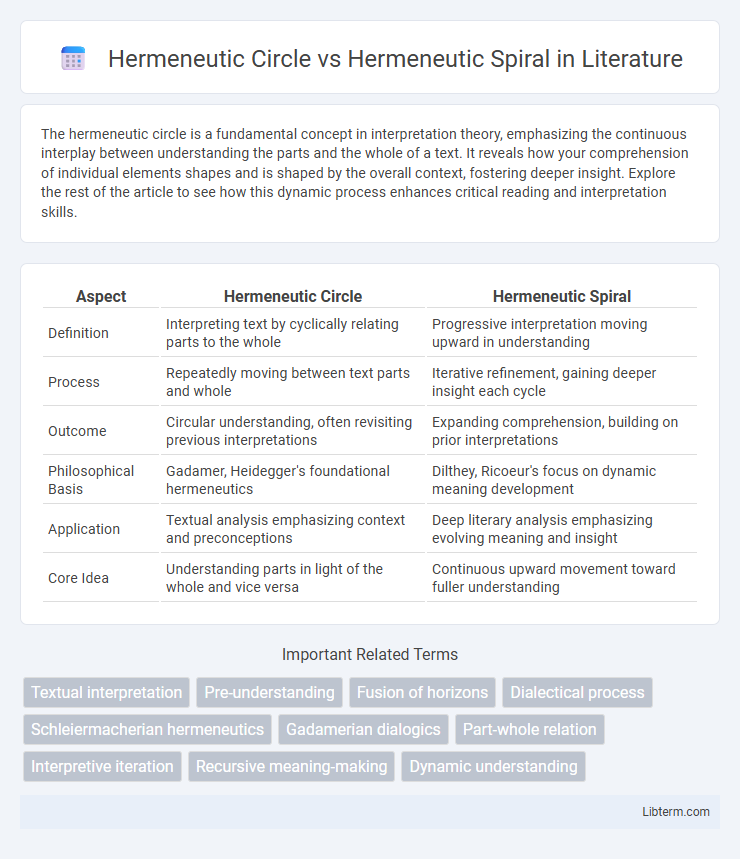The hermeneutic circle is a fundamental concept in interpretation theory, emphasizing the continuous interplay between understanding the parts and the whole of a text. It reveals how your comprehension of individual elements shapes and is shaped by the overall context, fostering deeper insight. Explore the rest of the article to see how this dynamic process enhances critical reading and interpretation skills.
Table of Comparison
| Aspect | Hermeneutic Circle | Hermeneutic Spiral |
|---|---|---|
| Definition | Interpreting text by cyclically relating parts to the whole | Progressive interpretation moving upward in understanding |
| Process | Repeatedly moving between text parts and whole | Iterative refinement, gaining deeper insight each cycle |
| Outcome | Circular understanding, often revisiting previous interpretations | Expanding comprehension, building on prior interpretations |
| Philosophical Basis | Gadamer, Heidegger's foundational hermeneutics | Dilthey, Ricoeur's focus on dynamic meaning development |
| Application | Textual analysis emphasizing context and preconceptions | Deep literary analysis emphasizing evolving meaning and insight |
| Core Idea | Understanding parts in light of the whole and vice versa | Continuous upward movement toward fuller understanding |
Introduction to Hermeneutics
The Hermeneutic Circle emphasizes understanding a text by iteratively interpreting parts and the whole, highlighting the dynamic relationship between context and meaning in Hermeneutics. The Hermeneutic Spiral expands this concept by suggesting a progressive, evolving interpretation process where each cycle deepens comprehension and broadens perspective. Both models are foundational in the Introduction to Hermeneutics, illustrating the interplay between preconceptions and new insights in textual interpretation.
Defining the Hermeneutic Circle
The Hermeneutic Circle defines the process where understanding is achieved by interpreting the relationship between the whole text and its individual parts, emphasizing that meaning emerges through this recursive interaction. This concept is central to hermeneutics, highlighting that preconceptions influence interpretation and that comprehension deepens as the parts illuminate the whole and vice versa. It contrasts with the Hermeneutic Spiral, which suggests a progressive and evolving understanding rather than a fixed circular process.
Understanding the Hermeneutic Spiral
The Hermeneutic Spiral represents an iterative process where understanding deepens progressively through continuous interaction between the parts and the whole of a text or experience. Unlike the Hermeneutic Circle, which suggests a repetitive loop, the spiral emphasizes forward movement and expansion of meaning with each interpretative cycle. This dynamic approach facilitates evolving comprehension, reflecting growth in insight rather than returning to the same interpretive point.
Historical Origins and Philosophical Context
The Hermeneutic Circle, rooted in 19th-century German philosophy by thinkers like Friedrich Schleiermacher and Wilhelm Dilthey, emphasizes understanding text through the iterative relationship between parts and the whole. In contrast, the Hermeneutic Spiral, developed later by philosophers such as Hans-Georg Gadamer, shifts this process toward a progressive deepening of interpretation influenced by historical context and the fusion of horizons. Both concepts arise from the philosophical tradition of hermeneutics that seeks to explain how meaning evolves through interpretative dialogue over time.
Key Differences: Circle vs Spiral
The Hermeneutic Circle involves an iterative process where understanding of the whole text is developed by interpreting its parts and vice versa, emphasizing a circular movement without progression. In contrast, the Hermeneutic Spiral represents a progressive deepening of understanding, where each cycle builds upon the previous interpretation, moving forward toward greater insight rather than merely revisiting the same circle. The key difference lies in the spiral's dynamic advancement in comprehension compared to the static repetitive nature of the circle.
Interpretative Processes in Each Model
The Hermeneutic Circle emphasizes an iterative interpretative process where understanding of the whole text emerges through continual reference between its parts and the entire context. In contrast, the Hermeneutic Spiral models interpretation as a progressive, dynamic movement toward deeper meaning, allowing for evolving comprehension with each engagement. Both models highlight the interplay between preconceptions and textual elements but differ in conceptualizing the progression of interpretative insight.
Applications in Textual Analysis
The Hermeneutic Circle facilitates textual analysis by emphasizing the iterative process of understanding parts of a text in relation to the whole, enabling deeper interpretation of meaning within complex literary works. The Hermeneutic Spiral refines this approach by promoting progressive understanding through continuous feedback loops, allowing analysts to build nuanced interpretations that evolve with each reading. Both models are crucial in fields such as literary criticism, theology, and law, where comprehensive and dynamic engagement with the text is essential for uncovering layered meanings.
Implications for Understanding Meaning
The Hermeneutic Circle emphasizes the iterative process of interpreting a text by continuously relating parts to the whole, suggesting understanding deepens as one revisits and refines interpretations. In contrast, the Hermeneutic Spiral advances this concept by proposing that each cycle of interpretation elevates comprehension to a higher level, implying progressive and enriching engagement with meaning. These models impact meaning comprehension by framing it as either a repetitive exercise (circle) or a dynamic, evolving journey (spiral) toward fuller insight.
Critiques and Limitations
The hermeneutic circle faces critique for its cyclical process, which can result in circular reasoning and potential interpretative stagnation. Critics argue that it lacks a clear pathway for progressing understanding beyond repetitive cycles of preconceptions and text analysis. The hermeneutic spiral aims to address these limitations by emphasizing iterative growth and refinement of interpretation, though it is sometimes criticized for being too abstract and insufficiently operationalized in practical hermeneutic methodology.
Conclusion: Choosing Between Circle and Spiral
The Hermeneutic Circle emphasizes an iterative process where understanding evolves through continuous interpretation of parts and whole, making it ideal for static or well-defined texts. The Hermeneutic Spiral, however, highlights progressive deepening and transformation of understanding, suitable for dynamic, evolving contexts and complex interpretations. Selecting between the circle and spiral depends on whether one requires a recursive reaffirmation of meaning or an expanding, transformative comprehension over time.
Hermeneutic Circle Infographic

 libterm.com
libterm.com